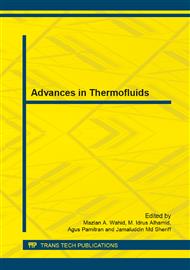[1]
F. Westin, J. Rosenqvist, H. Angstorm, Heat losses from the turbine of a turbocharged SI-Engine – Measurement and Simulation, SAE Technical Paper Series, (2004).
DOI: 10.4271/2004-01-0996
Google Scholar
[2]
N. Baines, K.D. Wygant, A. Dris, The analysis of heat transfer in automotive turbocharger, Proceedings of ASME Turbo Expo 2009: Power for land, Sea and Air.
Google Scholar
[3]
A. Romagnoli, R. Martinez-Botas, S. Rajoo, Steady performance evaluation of variable geometry twin-entry turbine, Int. J. of Heat and Fluid Flow. 32(2011) 477-489.
DOI: 10.1016/j.ijheatfluidflow.2010.12.002
Google Scholar
[4]
D. Bohn, T Heuer, K. Kusterer, Conjugate flow and heat transfer investigation of a turbocharger, J. Eng. For gas turbines and power. 127(2005) 663-669.
DOI: 10.1115/1.1839919
Google Scholar
[5]
M. Cormerais, P. Chesse, J. Francois Hetet, Turbocharger heat transfer modeling under steady and transient conditions, Int. J. Thermodynamics. 12(2009) 193-202.
Google Scholar
[6]
A. Romagnoli, R. Martinez-Botas, Heat transfer on a turbocharger under constant load points, Proceedings of ASME Turbo Expo 2009: Power for Land, Sea and Air.
DOI: 10.1115/gt2009-59618
Google Scholar
[7]
H. Hiereth, P. Prenniger, Charging the internal combustion engine, Springer-Verlag Wein, Austria, (2007).
Google Scholar
[8]
G. Descombes, J. F. Pichouron, F. Maroteaux, N. Moreno, J. Jullien, Simulation of the performance of a variable geometry turbocharger for diesel engine road propulsion, Int. J. Applied Thermodynamics. 5(2002) 139-149.
Google Scholar
[9]
Y. A. Cengel, A. J. Ghafar, Heat and mass transfer fundamentals and apllications, Fourth ed., McGraw Hill, New York, (2011).
Google Scholar
[10]
S. Shaaban, Experimental investigation and extended simulation of turbocharger non-adiabatic performance, PhD thesis, University Hannover, (2004).
Google Scholar
[11]
Saqr, K.M., H.S. Aly, H.I. Kassem, M.M. Sies, and Mazlan A. Wahid, Computations of Shear Driven Vortex Flow in a Cylindrical Cavity Using a Modified k-e Turbulence Model. International Communications in Heat and Mass Transfer, 2010, 37(8) pp.1072-1077.
DOI: 10.1016/j.icheatmasstransfer.2010.06.021
Google Scholar
[12]
Saqr, K.M., H.S. Aly, M.M. Sies, and Mazlan A. Wahid, Effect of Free Stream Turbulence on NOx and Soot Formation in Turbulent Diffusion CH4-Air Flames. International Communications on Heat and Mass Transfer, 2010. 37 (6): pp.611-617.
DOI: 10.1016/j.icheatmasstransfer.2010.02.008
Google Scholar
[13]
Saqr, K.M., H.S. Aly, and Mazlan A. Wahid, and M.M. Sies, Numerical Simulation of Confined Vortex Flow Using a Modified k-epsilon Turbulence Model. CFD Letters, 2009. 1(2): pp.87-94.
Google Scholar
[14]
Kassem, H.I., Saqr, K.M., Mazlan A. Wahid, Implementation of the eddy dissipation model of turbulent non-premixed combustion in OpenFOAM. International Communications in Heat and Mass Transfer, 38 (2011) 363 – 367.
DOI: 10.1016/j.icheatmasstransfer.2010.12.012
Google Scholar
[15]
Saqr, K.M., H.S. Aly, M.M. Sies, and Mazlan A. Wahid, Computational and Experimental Investigations of Turbulent Asymmetric Vortex Flames. International Communications in Heat and Mass Transfer, 38 (2011).
DOI: 10.1016/j.icheatmasstransfer.2010.12.001
Google Scholar


